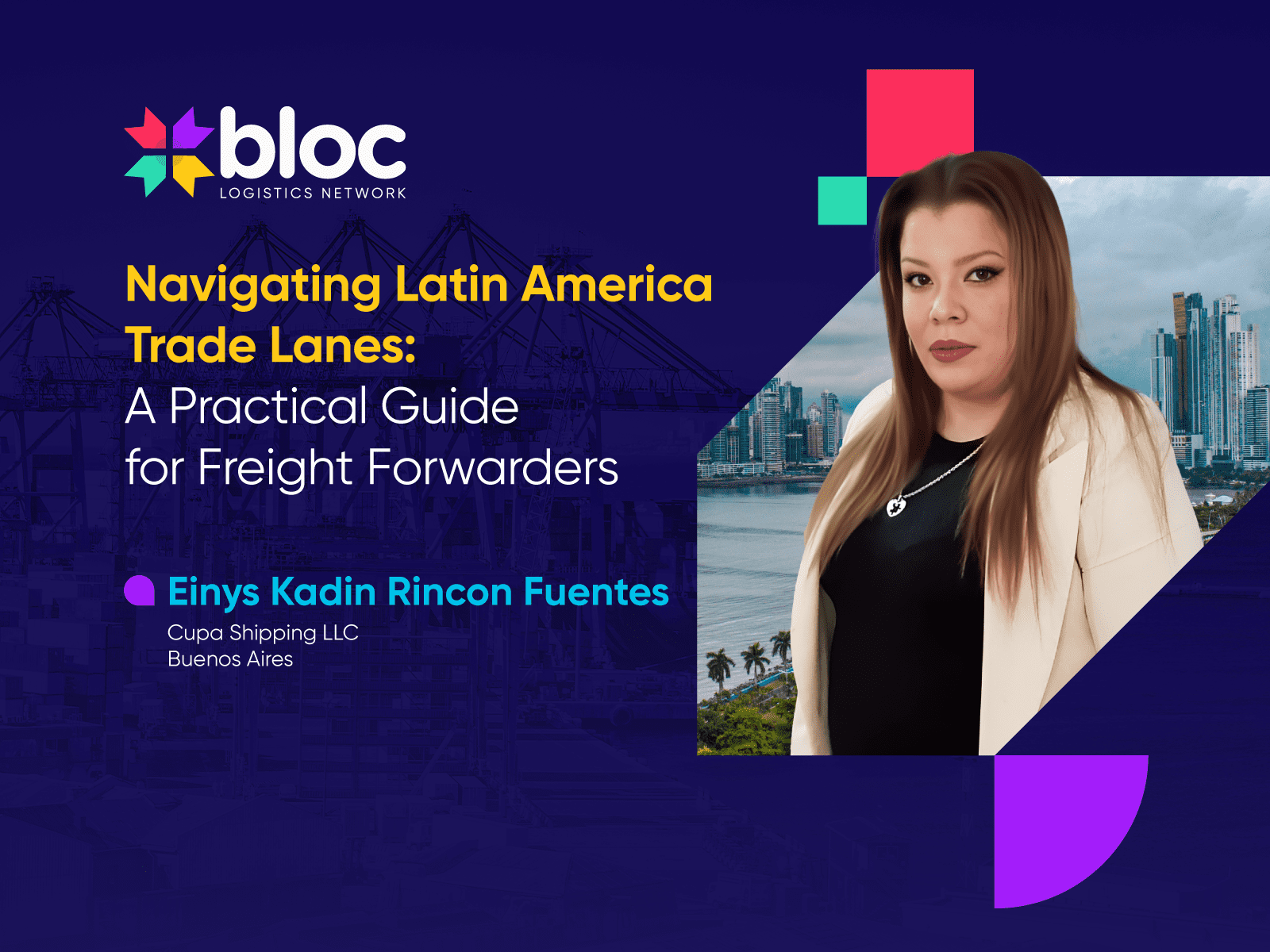By: Einys Kadin Rincon Fuentes, Director & CEO of Cupa Shipping LLC, Buenos Aires
Having spent my career in Latin American logistics, I’ve seen countless freight forwarders approach this region with high hopes and standard playbooks—only to discover that what works in Europe or Asia doesn’t necessarily translate here. The good news? Once you understand the fundamentals, Latin America offers some of the most rewarding opportunities in global logistics.
With over $5 trillion in combined GDP and rapidly growing intra-regional trade, Latin America isn’t just another market to consider—it’s becoming essential for any forwarder with global ambitions. But success here requires a different approach, one that embraces local complexities rather than fighting them.

Understanding the Latin American Landscape
Let me start with something that surprised me early in my career: Latin America isn’t just one market—it’s 33 distinct countries, each with its own regulatory framework, business culture, and logistics challenges. Brazil dominates with 40% of regional GDP, while Mexico serves as your gateway to North American trade connections. Argentina, Chile, Colombia, and Peru each offer unique opportunities if you know how to approach them.
What’s particularly exciting right now is the infrastructure development happening across the region. The Integration of Regional Infrastructure in South America (IIRSA) projects are creating new trade corridors that connect previously isolated markets. Meanwhile, the Pacific Alliance countries have eliminated tariffs on 92% of their traded goods, and MERCOSUR continues to offer preferential agreements that benefit logistics providers who understand how to use them.
This isn’t just growth—it’s the emergence of a truly integrated regional economy that’s reshaping global trade patterns.
Building Your Partner Network: The Key to Everything
Here’s something I learned through my years in logistics: your success in Latin America will largely depend on your local partners. You can have the best systems and procedures in the world, but without reliable partners who understand local customs, regulations, and business practices, you’ll struggle.
The challenge is finding the right partners. I’ve seen too many international forwarders rush into partnerships with the first local agent who promises quick results. That approach rarely ends well.
- Solid financial standing with verifiable references
- Clean regulatory compliance records
- Technology systems that can integrate with yours
- Physical facilities you can visit and inspect
- A willingness to invest time in understanding your business
My experience suggests starting with 3-5 key markets rather than trying to cover the entire region at once. This approach lets you build strong relationships and refine your operations without spreading yourself too thin. At Cupa Shipping, our partnerships through the Bloc Logistics Network have been instrumental in providing reliable coverage across multiple countries.
Mastering Regional Regulations
Every Latin American country has its own regulatory personality, and understanding these differences is crucial for smooth operations. Brazil, for instance, requires extensive documentation that can overwhelm newcomers—commercial invoices, packing lists, certificates of origin, and more. Mexico emphasizes advance filing requirements with strict penalties for non-compliance that can seriously impact your margins.
The real opportunities often lie in understanding free trade agreements. The Comprehensive and Progressive Trans-Pacific Partnership (CPTPP) includes Mexico, Chile, and Peru, offering significant duty reductions for qualifying shipments. But—and this is important—”qualifying” means having perfect documentation and understanding rules of origin requirements.
Tax implications vary dramatically across the region. Argentina applies 21% VAT on most imports, Chile uses 19%, and some countries offer industry-specific incentives that can significantly reduce your clients’ total landed costs. Understanding these nuances helps you provide genuine value beyond just moving boxes.
Currency volatility is another reality you’ll need to manage. Regional currencies can fluctuate significantly, affecting both your pricing and profitability. Developing hedging strategies and flexible pricing mechanisms protects your margins while keeping you competitive.
Designing Your Service Portfolio
Ocean freight forms the backbone of Latin American trade, driven by geography and cost considerations. Understanding which ports matter makes all the difference. Santos handles Brazil’s industrial exports, Veracruz serves Mexico’s manufacturing corridor, and Buenos Aires connects Argentina’s agricultural sector to global markets.
Air freight through hubs like São Paulo, Mexico City, and Bogotá fills critical gaps for time-sensitive shipments. Success here requires understanding seasonal capacity constraints and rate patterns that can vary dramatically throughout the year.
Don’t overlook overland transportation, especially for landlocked countries like Paraguay and Bolivia. Cross-border trucking requires specialized knowledge of customs procedures, transit agreements, and security protocols. Partnering with established trucking companies that maintain proper permits and insurance is essential.
One area that’s particularly rewarding is project cargo and specialized handling. Latin America’s growing mining, energy, and infrastructure sectors generate consistent demand for heavy-lift and oversized cargo transportation. Developing these capabilities can create significant revenue opportunities.
Embracing Technology and Innovation
Digital transformation in Latin American logistics has accelerated dramatically in recent years. Electronic bills of lading, digital customs declarations, and automated clearance systems are becoming standard across major markets. Early adoption gives you competitive advantages and improves client service.
Your clients increasingly expect real-time visibility across their supply chains. This means investing in integrated platforms that provide seamless tracking across multiple countries, transportation modes, and currency zones. The complexity shouldn’t be your client’s problem—it should be invisible to them.
Data analytics help identify trends and optimize operations. Historical shipping data reveals seasonal patterns, route performance metrics, and cost optimization opportunities that inform better strategic decisions. Mobile applications facilitate communication with partners and provide clients with the visibility they expect.
Financial Planning for Success
Expanding into Latin American markets requires different financial planning than you might be used to. Extended payment terms, currency conversion delays, and the need for local banking relationships all affect cash flow management. Establishing credit facilities and clear payment collection procedures before you start operations saves headaches later.
Insurance coverage must address regional risks including political instability, currency devaluation, and natural disasters. Comprehensive coverage protects both your operations and your clients’ shipments against risks that standard policies might not cover.
Pricing strategies should reflect local market conditions while maintaining your profitability. Research competitor pricing, understand client expectations, and develop flexible models that can adapt to currency fluctuations and changing market conditions.
Building relationships with local banks facilitates payments, currency conversion, and trade financing options for your clients. These relationships also provide valuable market intelligence and regulatory updates.
The Relationship Advantage
One thing that sets Latin American business culture apart is the emphasis on personal relationships. The logistics provider who takes time to understand local customs, visits regularly, and builds genuine partnerships consistently outperforms those who treat the region as just another market to serve remotely.
Cultural sensitivity isn’t just good manners—it’s good business. Understanding local holidays, business practices, and communication styles helps build the trust that forms the foundation of long-term success.
At Cupa Shipping, we’ve found that patience and commitment to relationship building create sustainable competitive advantages. The Latin American market rewards consistency and genuine partnership over quick transactions.
Looking Forward
The Latin American logistics market is evolving rapidly, creating unprecedented opportunities for freight forwarders willing to invest in understanding its complexities. The infrastructure improvements, trade agreements, and growing intra-regional commerce are creating a foundation for sustained growth.
Success here isn’t about conquering a market—it’s about becoming part of a community. The forwarders who embrace this approach find themselves with loyal clients, reliable partners, and sustainable growth that global competitors struggle to replicate.
The opportunity in Latin America is real and growing. The question is whether you’re ready to approach it with the patience, cultural sensitivity, and long-term commitment it rewards.

Article by Einys Kadin Rincón Fuentes
Director & CEO,
Cupa Shipping LLC, a member of Bloc Logistics Network
Cupa Shipping LLC is a global logistics provider established in 2008, offering comprehensive freight services across air, ocean, and road, including specialized and hazardous cargo. The company also provides warehousing, supply chain consulting, and last-mile delivery, supported by advanced technology for real-time tracking and compliance. Known for its customer-centric approach, CUPA SHIPPING delivers tailored, cost-effective solutions with 24/7 support and a strong track record in complex logistics.
Bloc Logistics Network is a global platform that connects logistics professionals to share opportunities and collaborate without barriers. Bloc aims to level the playing field by creating an accessible, supportive environment where professionalism and collaboration drive real results. It serves as an ecosystem designed for mutual advancement, ensuring growth, efficiency, and success across the logistics industry.





